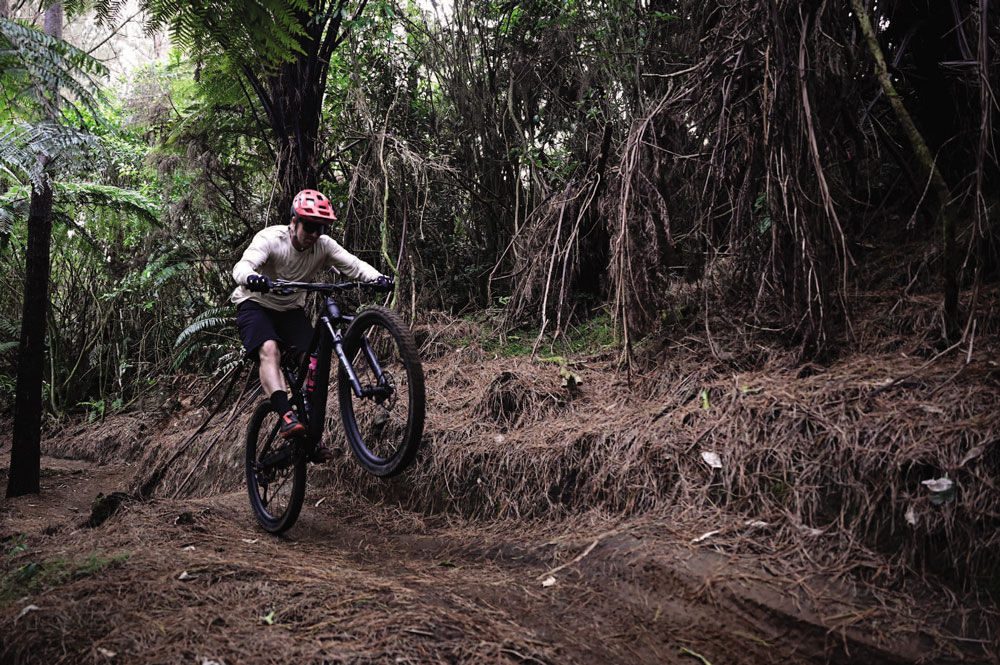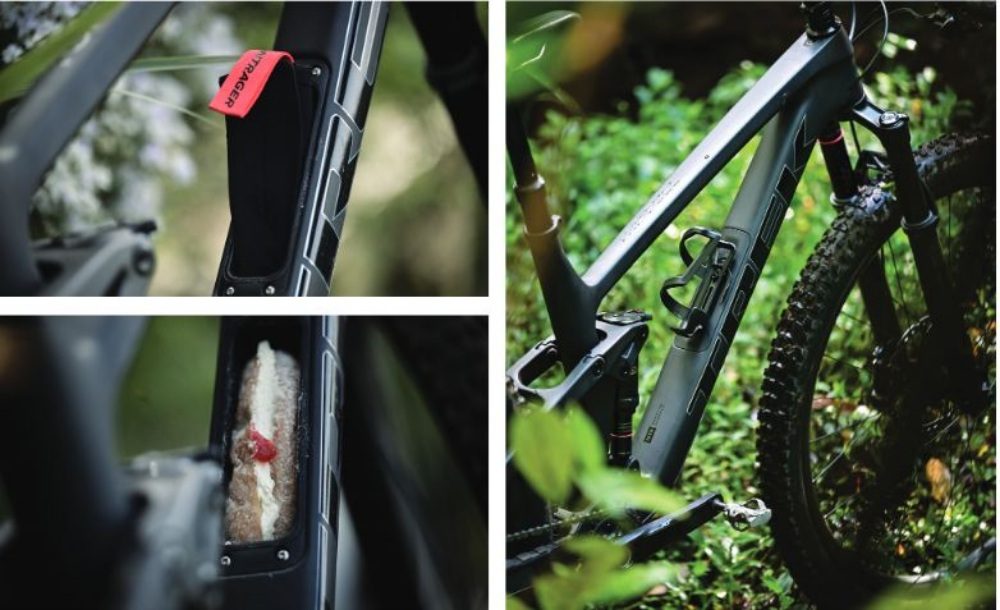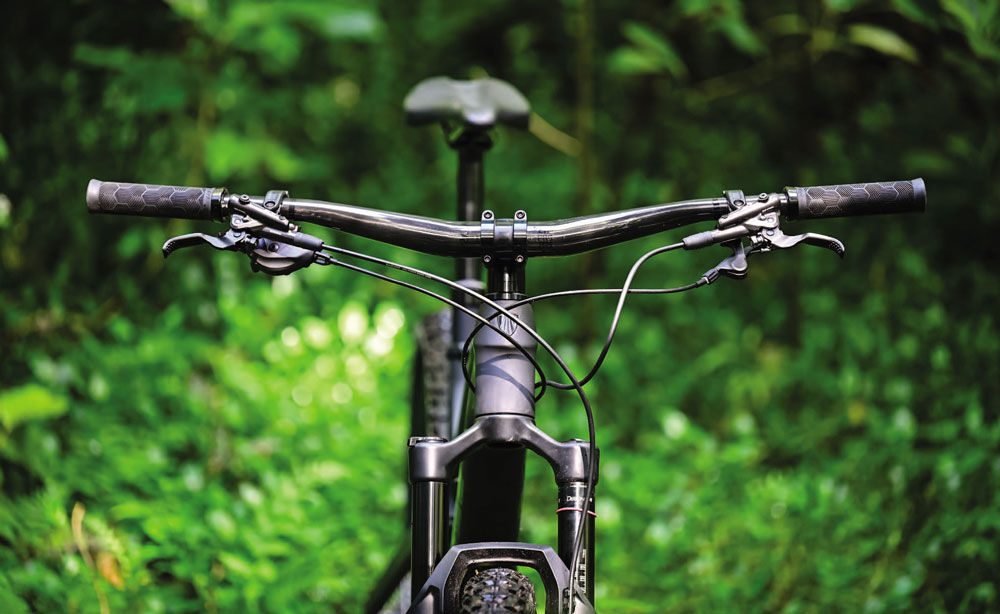“The Trek 2022 Top Fuel responds really well to rider input and, as a result, is simply really fast.”
The process of evolution involves a series of natural changes that cause species to arise, adapt to the environment and, sometimes, to become extinct. From walking on two legs to riding bikes and now having the ability to ride bikes off cliffs at Redbull Rampage shows how far we’ve come!
Just like us, bikes tend to evolve too; the Top Fuel we’ve had on review for the last two months is a perfect example of that. Previously Trek’s XC race bike that evolved into a marathon bike, it has evolved again, and Trek fans might be wondering just what exactly the new Top Fuel is now?
Trek’s Supercaliber, with exclusive IsoStrut shock, 60mm of travel and unique pivotless seatstays, sits in the XC race seat the Top Fuel used to occupy in Trek’s stable. This has given the Top Fuel the opportunity to evolve out of that same XC space into something new, and that’s exactly what it has done.

So, is it a ‘trail bike’? Is it a ‘down country bike’? Or is it just what we also thought a ‘mountain bike’ was?
Previous Top Fuel fans might even be asking, ‘has it evolved too far?’
In New Zealand, the Top Fuel will be available at eight price points. As mentioned, we’ve had the 9.8 XT model, worth $8849, but it’s also available in two alloy models which offer the most affordable entry points; the Top Fuel 5 at $3799. Entry into the carbon options is the 9.7 ($6599), going all the way up to 9.9 XX1 AXS Project One, for $15,449.
So, what are the key changes that have been made in the process of evolution? For 2022, travel in the rear ups from 115mm to 120mm.
To be fair, 5mm extra travel isn’t really much of a game-changer but upping to 120mm sends a signal that this isn’t, in fact, a slightly evolved XC bike – this is definitely an all-new Top Fuel. Making all that 120mm of travel work, is Trek’s ABP rear pivot system.

We’ve always been a fan of this system – the rear axle pivot rotates directly around the axle point, and this allows Trek to tune how the suspension reacts to acceleration and braking forces independently.
At the lower shock mount, Trek’s flip chip style geometry adjustment, the Mino Link, lets you fine tune your frame geometry ‘on the go’.
In reality, it’s not likely you’d be doing that out on the trail but in the comfort of your garage, where you aren’t worried about losing precious shock hardware in the dirt, you can flip the Mino Link. Stay in low for a slack 66-degree headtube angle. Flip it for a quicker 66.5-degree headtube angle and a 7mm higher bottom bracket for more ground clearance. All of that is driving the RockShox Deluxe Ultimate RCT shock.
Up front sees the new Rock Shox Sid Select+ 120mm fork. At upward of $8800, we’d really love to see the Sid Ultimate, which gets the benefit of the improved Charger Race Day, over the Charger 2 RL that come on the Select+. However, you still get the full carbon OCLV frame along with Bontrager’s Line Elite carbon wheels, and a full XT build kit from tip to tail, including the superb 4-pot XT calipers and a 10-51 tooth cassette. Everyone seems quite particular about which drivetrain team they are on, so Trek offer their 9.8 and 9.9 models in either SRAM or Shimano build kits.

Out of the box, we personally liked the matte carbon look with holographic details around the edge of the logos. It’s subtle, smart and stealthy. This is the cheapest option at the 9.8 spec level. It’s also available in gloss black with a red swingarm, but this is essentially one of their Project One custom paint jobs, and you’ll pay an $1800 premium to get it. That’s some expensive paint.
For us, the pick of the bunch has to be the striking red/purple/yellow fade on the 9.8 GX build. Sadly, that one carries the $1800 paint premium too so will set you back $10,649 total. With all that in mind, the matte carbon XT option looks pretty good. To be fair, the Project One custom paint options that Trek offer are pretty amazing and their paint configurator is also a great way to kill an hour – don’t say we didn’t warn you. It’s cool to see companies allowing this kind of customisation.
All the housing is internal, which completes the sleek look. Your tool kit is also internal! Or it can be, if you want it to be, with a handy tool storage compartment integrated under the bottle cage and a complementary Bontrager Bits pouch to wrap things in. We can now confirm that alongside a small tool kit, you can also squeeze a long cream donut – in case you’re worried about going calorie negative during a ride (who says we don’t do hard-hitting journalism here at NZ Mountain Biker?!).
At the bottom of the down tube there is a plastic armoring to protect the carbon, and a chunky rubberised chain- stay protector to keep things quiet. Trek fans will see the return of the Knock Block, now updated to the Knock Block 2.0, which keeps cables from getting yanked out in a crash and protects the top tube. The only difference being that it now provides an improved 72-degrees of turning radius.

Interestingly, for an XC- ish oriented bike, there is only one bottle cage mount. This seems strange, as this kind of bike seems perfect for longer rides and maybe even marathon races. With 120mm travel, 66.0-degree head angle, and 2.4” tyres, the Top Fuel is set (on paper at least) to be a pretty fun whip and, as we’ve been saying, firmly has its place in the ‘trail’ category. The question Trek buyers might be asking is, ‘is this basically just a new Fuel EX?’ Looking at the numbers, you certainly have to wonder if the difference is big enough? And, if you’re tossing up between the Top Fuel and the Fuel EX, which one should you buy? The Fuel EX is a 130mm travel bike with a 140mm Fox 36 fork. They’ve both got a 66-degree head angle, their wheelbase is almost identical (121.5 for Top Fuel size large, 121.1 for EX) but the reach on the Top Fuel is actually longer (48.0 for the Top Fuel vs 47.0 for the EX). If anything, this probably just signals that the EX is due for a refresh, so we would be surprised if we didn’t see that for 2023, where we expect it will get a similar treatment with a bit more travel and a bit slacker head angle. That will make you wonder if the 150mm Remedy, the last remaining 27.5 wheel bike in the lineup, really has a place any more?
Anyway, all that is Trek’s marketing problems to worry about. Our job is to ride the Top Fuel we have today. Trek describes the Top Fuel as the perfect bike for riders who like to stay pinned both up and down the trail. The term ‘Top Fuel’ is a term associated with American drag racing, which is all about acceleration, so we were expecting this to be a bike that would draw on its XC roots and get up to speed fast – but with modern geometry and tyres that give confidence to push through the corners. Even though we spent two months on it, it didn’t take much riding at all to confirm this indeed lives up to its marketing team’s hype that the “Top Fuel loves to pedal up – lives for challenging descents”. At the end of our review period, we were left thinking, ‘this is the kind of bike a lot of people could be riding’. The Top Fuel gets so much right; the handling is sharp, and the suspension is both active and supportive. It’s the kind of bike that, when you get to the bottom of a rowdy descent and you know you’ve got a decent uphill ahead, you don’t drop your head and wish you were on an e-MTB; instead, you just get on with the pedalling – and might even find you’re kind of enjoying it. Our totally unscientific belief is that, thanks to effective marketing, more riders are riding longer-travelling, heavier, squishier (yes, it’s a technical term) bikes than perhaps the terrain actually requires, and this has really taken the shine off something we are doing a lot of the time, despite what we like to think: riding up hills. Part of this trend to longer travel and overall extra beef, has been about geometry. It has only been longer travel bikes that have had the matching geometry that inspires confidence at speed, or over steep terrain. But, with more modern geometry (read: longer, slacker) trickling into bikes like the Top Fuel, you now have the choice of riding lighter, shorter travel bikes with more confidence over technical terrain. Do you really need 160mm of travel for your everyday ride? Maybe, but probably not. Maybe you’re happy to ride a bike with less travel, but there just haven’t been shorter travel bikes with the corresponding geometry that makes riding downhills a real hoot? This is what the Top Fuel is all about.
Tyre choice can be one of the most significant choices in what terrain a bike will excel on, and with Trek spec-ing the new 2.4” XR4 tyres, they clearly had this in mind. They are noticeably chunkier tyres than you might find on a 120mm travel bike, and probably reflect the kind of personal changes most riders end up making to their bikes in time. The XR4 tyres are worth pausing on for a moment, because they really are a bit of a Goldilocks tyre: not too heavy, not too light – just right. We only mention it because so often tyres seem to just miss the mark. The XR4’s do a great job of hitting just the right balance of speed and control to enable the bike to do what it was designed to do. 2.4” might sound wide but, just like the nation tuning into daily press conferences, it’s the ‘new normal’.



On the suspension front, the Deluxe Ultimate rear shock does a superb job at managing the rear travel through rowdy terrain, however, it does tend to show the limitations of the Select+ front fork. It’s not that the fork is bad – in fact, there is a lot to like – but it has an incredibly light breakaway (to minimise stiction, the SID Select+ is now using Maxima Plush damping fluid and SKF wiper seals) which means it does a superb job at absorbing small trail chatter. But, with only 120mm of travel to work with, mid-stroke damping is critical, and this is where the Select+ can’t keep up. A damper upgrade is around $300-$400, so not insignificant. It’s worth pointing out that upgrading to the SID Ultimate fork is also something you can specify in the Project One bike configurator. Interestingly, Trek say the frame is rated for a 130mm fork as well so, if this was our bike, we’d be seriously considering flicking the fork at the outset and putting that coin towards a Pike Ultimate, which would take the bike a further step away from the XC end of the spectrum. We think this better represents the kind of riding that buyers would be purchasing this for and would make better use of the bike’s capabilities as a whole.
The Bontrager carbon wheelset is worth mentioning. Rolling on the Line Elite rims, they are built from proven OCLV Elite Carbon for an optimized blend of weight, strength, and durability. They held up well during our test. The 108pt engagement freehub delivers rapid pickup at the pedals, but is definitely on the noisier end of the spectrum so you’ll either love it or hate it. There is something kind of obnoxiously satisfying about coasting up behind your riding partner while your freehub is screaming at them, just subtly letting them know that you’re coasting right now and could they please speed up?
The Top Fuel’s strength is that it just does so much of what a lot of us actually do – really well. For a lot of riders, the majority of actual hours spent riding isn’t on either an XC or Enduro race track; it’s probably spent heading out for just a few hours, with a mate or two, once or twice a week. It’s riding a bit of everything; the up and the down – and actually wanting to enjoy both.
It’s not launching five metre gap jumps, but it’s not riding around the one or two metre gap jump either.
It’s the every day, every trail fun that is in the Top Fuel’s sights. It’s responsive, gets up to speed quickly and responds really well to rider input, such as pumping through rollers and, as a result, is simply really fast. It’s fun and efficient at every task and we think it will be a really good fit for a lot of riders. •
REVIEW: LANCE PILBROW
DISTIRIBUTOR: TREKNZ
RRP: $ 8 ,849

